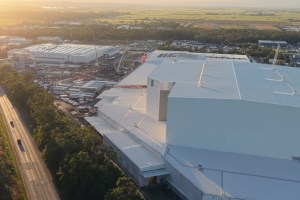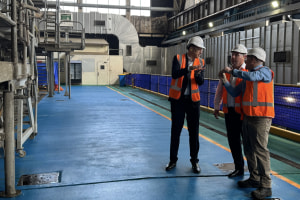High-bay technologies are bringing manufacturing and warehousing facilities closer than ever before, writes Vaughan Constructions' Andrew Noble.
The possibility of placing manufacturing and distribution facilities next to each other or even in close proximity to each other has been almost impossible for leading FMCG players in the past. This has been a result of the hefty amount of land required in order to achieve capacity requirements for large distribution centres, not to mention the cost of the land itself.
Now, with the development of high-bay technology, manufacturing and warehousing facilities are moving closer than ever before. Not only in proximity but in design involvement also.
Vaughan Constructions, a national builder and developer, has worked with some of the largest FMCG players including Diageo, PepsiCo, Coca-Cola Amatil (CCA) and Woolworths to develop their latest high-bay projects. Here are some of our learnings.
What is a high-bay warehouse?
Dubbed as ‘black warehouses’, high-bay facilities are fully automated warehouses which are generally over 30 metres tall and predominantly dark and unoccupied. They are developed based on the principle of occupying a limited footprint and achieving maximised high-density storage. High-bay warehouses can be directly connected with the place of production or purely used as a storage and distribution centre.
High-bays consist of narrow racking aisles which allows for the efficient store of goods. Developments in robotics and picking technology has made this possible, as machinery allows for the storage of product and also will select product and take it to distribution areas without the need for a human-operated forklifts that are synonymous with standard warehouses.
The latest technology
The adoption of learning algorithms within the warehouse management software is further improving speed and accuracy of picking. Full Robotic intervention has been most successful where entire pallet picking is required. A human workforce has always had an advantage over robots where reasoning is required to identify an individual SKU from a pallet or picking space, determine how grasp it and maintain appropriate pressure without damaging the packaging or the contents.
However, that advantage gap is fast diminishing as robots learn not only teach themselves the quickest receive or dispatch configuration, they can also learn dexterity and differentiate between SKUs to pick an individual product.
These technological advances have improved the speed throughput of materials/ product at near 100 percent accuracy levels. The technology allows for efficient inventory handling, a reduction in warehouse labour, improve accuracy in inventory and order fulfilment as well as lessening the facility’s demand for fork lift usage.
PepsiCo’s Regency Park (SA) high-bay facility allows for product to be automatically packed and travel from the manufacturing packaging room. Every carton of product is then automatically palletised and stretch wrapped and labelled. The pallet is then transported to another automated warehouse or direct to the dock for distribution to customers. This process occurs in the dark and is available 24 hours, significantly improving PepsiCo’s productivity and bottom-line.
Why proximity is key
With high-bay solutions occupying a fraction of the land required for a standard distribution centre, it has given companies added flexibility in securing sites for both their manufacturing/production and distribution facilities.
The advantage of manufacturing products closer to the storage and distribution facility is that it significantly reduces the cost of logistics, its a more environmentally sustainable option and it reduces the time from production to sale.
When developing and constructing facilities for Coca-Cola Amatil, PepsiCo and Diageo, Vaughan Constructions has found that these principles apply.
Coca-Cola Amatil’s Northmead (NSW) 32m high-bay warehouse required only 15,000m2 of land. In order to reach the same capacity at a 10 storey height limit, CCA would have required approximately 80,000m2. SKU’s from the CCA Northmead site have their first human interaction at the delivery destination.
In order to place PepsiCo’s distribution facility adjacent from the manufacturing site in Regency Park (SA), PepsiCo had major land restrictions to work with as well as meeting the large volume of storage requirement. This resulted in a 32m high-bay solution. As a result, PepsiCo can now store enough product providing sufficient capacity to cater for peak periods as well as future growth.
Vaughan also built a 32m high-bay facility for Diageo Australia located in Huntingwood (NSW) which has the capacity to handle its entire national footprint with usage of only 5,224m2 of land.
Serious competitive advantages from positioning major manufacturing and distribution facilities in close proximity are being realised by leading Beverage suppliers. It allows businesses to implement technology which completely transforms and streamlines the process. To put it simply - Its a faster, more efficient way of transporting product whilst reducing the rate of error, maintaining product integrity and reducing product miles.
Designing your high-bay facility
Warehouses and Distribution centres have historically been perceived as relatively simple passive buildings. Now, both manufacturing/ production and distribution facilities are highly automated operations that require significant planning and consideration.
In developing CCA’s high-bay facility, Vaughan worked with suppliers on the design of the fully automated materials handling system which utilised a rack clad building design. This eliminated the need for structural steel by building around the racking, ensuring no space was wasted on high-cost land.
Packaged food and beverage companies are leading the way with implementing advanced high-bay warehousing solutions.
Capital investments need to work hard to provide an appropriate return on investment. Embracing new automation technology and construction techniques are leading a revival in food & drink production by providing a next generation competitive edge.
ABOUT THE AUTHOR
Andrew Noble is director and general manager at Vaughan Constructions, a company that designs and constructs industrial, commercial, residential and retail facilities. He has been with Vaughan since 1988 and over this time he has managed all aspects of the design and project/construction management delivery chain.






